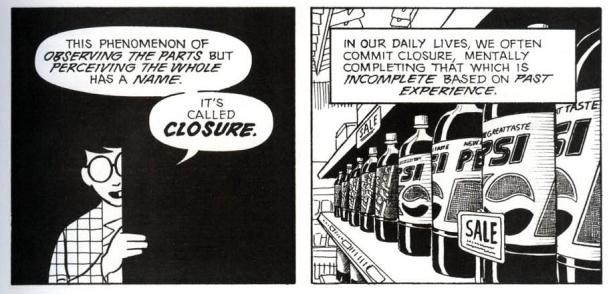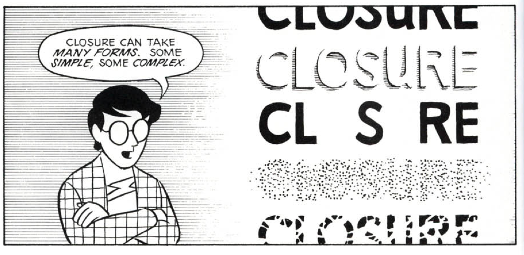One concept of comic art introduced by Scott McCloud in his clever book Understanding Comics is that more abstract images invite the reader to extend himself into a story.

Whereas a detailed portrayal of a human is more uniquely someone else, simplistic drawings don’t have features that are exclusive, and therefore are welcoming to anyone. This is called universal identification.
*
In the next chapter McCloud talks about closure, which in comics is found in the space between panels, i.e. the gutter.

Closure is filing in the gaps. In comics, that is drawing an understanding of two panels in a way that makes them fit together.

A connection that can be made here between two concepts in two different chapters is this: both universal identification and closure draw upon reader involvement, and reader involvement can vary because it draws on different individuals with unique experiences, tastes, and expectations.
The amount of closure needed can vary depending on how much control the artist takes and gives. Not much piecing together is needed in moment-to-moment panel sequences, like a woman waving, but in the image above, more connections need to be made.
Based on these two panels, what did you make happen? For me, my mind allowed the perceived victim to turn on his attacker in the last moment and kill him. Perhaps the artist intended the more obvious chain of events, but given what is missing in this little story, who is to say my twist didn’t happen? McCloud himself said that I am the one committing the crime. I subconsciously chose what happened.
So, just as we can put ourselves in comic stories, we can affect the story with how we close the gutters. Here my expectation was one thing and yours could be another.
*
Closure does not come just in the form of negative space between two drawings, though.

If you escape the comic medium, where else in storytelling do you find yourself tying two things together?
I see film transitions giving closure, fading out from one scene and fading in on a new one. From the clips on either side of that black screen, we could be with a young couple in Italy at an expensive restaurant one moment and the next with them watching the sunset on a gondola. What is the connection between those two different times?

I see books giving closure. Words are formatted in certain ways – by paragraphs, by chapters. When I was younger and typing out my stories, I would often put one of these two symbols (* / ~) between scenes to show a change of location or time. That was me unknowingly hinting for closure to be drawn.
In this blog post I have been asking you to bridge idea transitions with asterisks. I could have used headings, but headings take a lot of effort out of closure.
Whatever medium is telling you something, it is asking for your involvement. The level of that depends heavily on how much control is relinquished by the artist, director, or writer. Sometimes you are led easily from point A to B, but sometimes the path is not so clear. Sometimes on that path you get to make pretty abstract inferences. How do you decide that to interpret? How much are you putting yourself in the story?

Great points Lizzie! I too discussed the ideas of closure and reader involvement, and you really helped me understand them better than I did just five minutes ago. I like the way you connected the different concepts from the chapters in Scott McCloud’s “Understanding Comics” because I have been having a little trouble keeping it all connected and together.
The example you gave of your own expectations and ideas for the panel from page 64 of McCloud’s book was interesting because I too changed what happened in the gutter. I like to think that the victim turned around and unleashed some serious self defense moves (that he forgot he knew or was waiting for the perfect moment to use) on his attacker which would knock the ax away and give him time to escape. Maybe the scream in the next panel is the attacker’s cry after the victim broke his nose. I don’t know what happened in that gutter, but I do know that because of closure and the level of involvement I have with the story I am free to make the story and actions my own, and I really like that idea.
LikeLiked by 1 person
wow, it never occurred to me to have the victim fight back. I like your narrative much better, hspur!
LikeLike